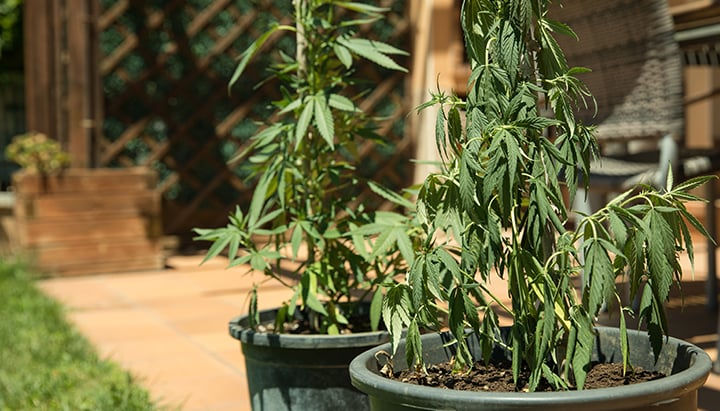What Are the Indicators of Overwatering and Underwatering Cannabis Plants?
- bayfrontbudz
- Jan 31
- 4 min read
Growing cannabis can be a fulfilling activity, but it can also be challenging, particularly when it comes to watering. The key to a thriving garden lies in understanding the signs of overwatering and underwatering. This blog post will help you identify these common issues, ensuring the health and vibrancy of your cannabis plants.
Understanding Watering Needs: Overwatering and Underwatering Cannabis
Cannabis plants thrive with a proper balance of moisture. Underwatering occurs when plants do not get enough water, causing drought stress. On the other hand, overwatering saturates the soil, depriving roots of necessary oxygen and promoting root rot. Recognizing the indicators of these extremes is critical for keeping your plants healthy.
Signs of Overwatering Cannabis

Overwatered plants exhibit symptoms that can easily be confused with other issues. Here are some clear signs to watch for:
Yellowing Leaves
Yellowing leaves, especially on the lower parts of the plant, are often the first indication of overwatering. For example, in a study by the Cannabis Research Institute, over 75% of growers reported yellowing leaves as a primary symptom. This yellowing occurs when excessive moisture prevents nutrient absorption, leading to deficiencies. If your cannabis leaves are turning yellow and becoming limp, it might be time to reassess how much water you’re giving them.
Wilting Leaves
Interestingly, overwatered cannabis can also appear wilted. This may lead to confusion, as underwatered plants have similar droopy leaves. The roots struggle to take up water due to overly saturated soil. Check for droopy leaves that feel soft—this could be a sign that your plants are overwatered.
Root Rot
Root rot is a more serious effect of overwatering, typically caused by fungal infections. Healthy roots are white and firm, while those affected by rot appear brown and mushy. According to research, nearly 30% of home-growers experience root rot within their first two growing seasons. To diagnose this issue, gently remove the plant from its pot and examine the roots.
Mold Growth
Excess moisture can lead to mold and mildew, particularly in the soil or on the plant leaves. If you see a white, fuzzy substance on the surface of the soil or the leaves, your watering habits may need adjusting. In a recent survey, 40% of growers faced challenges with mold due to overwatering.
Slow Growth
Overwatered plants often show stunted growth. Poorly oxygenated roots can hinder the plant’s ability to absorb nutrients effectively. If you notice a lack of growth in your plants, it may be due to overwatering.
Recognizing Underwatering Cannabis

On the contrary, underwatering can significantly harm your cannabis plants. Look for these signs to determine if your plants are thirsty:
Dry, Crispy Leaves
One clear sign of underwatering is dry, crispy leaves. When cannabis plants do not receive adequate moisture, the leaves may curl and harden. If the issue isn’t addressed quickly, this could lead to permanent damage. A study showed that plants left underwatered for too long can lose up to 50% of their biomass.
Brown Leaf Tips
Brown tips on leaves are another common indicator of underwatering. The lack of moisture prevents the plant from maintaining healthy growth, causing browning and crisping at the edges. If you notice these brown tips, it’s time to increase hydration.
Soil Conditions
To get a true sense of whether your plants are underwatered, check the soil. If it feels dry, crumbly, and lacks moisture, your plants are likely in dire need of water. Research indicates that many growers wait too long to water, resulting in loss of yield.
Wilting Leaves
Underwatered plants can also have wilting leaves. However, unlike overwatered plants, these leaves will appear dry and crispy, not limp. Wilting is a sign that plants are in distress, and immediate action is required.
Stunted Growth
Stunted growth is a key indicator of underwatering. Just like with overwatering, insufficient moisture can severely limit a plant's development. This can lead to a slower harvest and decreased yield.
Tips for Maintaining Proper Watering Practices
With an understanding of the signs of overwatering and underwatering, you can improve your watering practices. Here are a few methods to follow:
Know Your Strain
Different cannabis strains have unique moisture needs. For example, Sativa strains typically require more water in warmer conditions, while Indica strains flourish with slightly drier soil. Familiarize yourself with the specific requirements of your strain to tailor your watering schedule effectively.
Check Soil Moisture Regularly
Use your finger or a moisture meter to determine the soil moisture level before watering. This simple practice can prevent both overwatering and underwatering, leading to healthier plants.
Water Thoroughly
When watering, ensure that you saturate the soil enough so that moisture reaches the roots deeply. This encourages healthy root growth and nutrient absorption.
Monitor Environmental Conditions
Keep a close eye on temperature, humidity, and light exposure. Warmer temperatures can increase evaporation, requiring you to water more often. Adjust to the environmental factors to meet your plants’ hydration requirements better.
Adjust Watering Schedule
Be flexible with your watering routine. Your plants may require more water during their flowering stage or less in cooler conditions. Monitor the plants closely and adjust accordingly for best results.
The Path to Healthy Plants
Being able to spot the signs of overwatering and underwatering cannabis plants is key to successful cultivation. By keeping an eye on yellow leaves, wilting, and soil conditions, you can make informed decisions about your watering practices. With a few simple adjustments to your routine, you can ensure that your cannabis plants thrive and produce a robust yield. Happy growing!

Comments